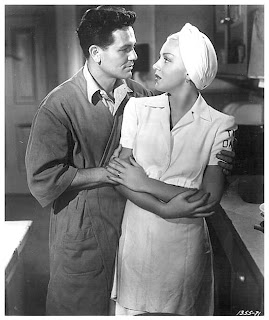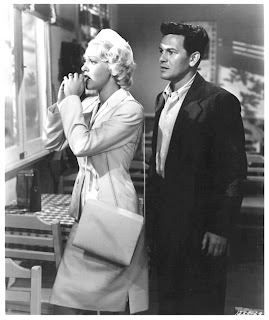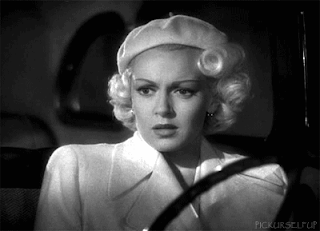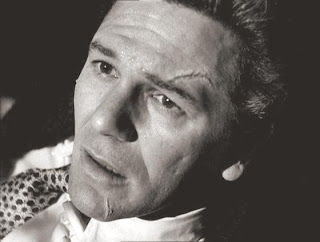 Frances Farmer & John Garfield in "Flowing Gold" (1940)
Frances Farmer & John Garfield in "Flowing Gold" (1940) John Garfield pulled strings to get Frances Farmer cast as his leading lady in "Flowing Gold" (1940). Both actors would eventually be destroyed by Hollywood's ignorance.
John Garfield pulled strings to get Frances Farmer cast as his leading lady in "Flowing Gold" (1940). Both actors would eventually be destroyed by Hollywood's ignorance.

 John Garfield and Lana Turner in Laguna Beach, filming "The Postman Always Rings Twice" (1946)
John Garfield and Lana Turner in Laguna Beach, filming "The Postman Always Rings Twice" (1946) Cecil Kellaway, John Garfield and Lana Turner in "The Postman Always Rings Twice" (1946)
Cecil Kellaway, John Garfield and Lana Turner in "The Postman Always Rings Twice" (1946) "I could never belong to only one man -- I belong to all men," says Lana Turner in 'The Prodigal'.
"I could never belong to only one man -- I belong to all men," says Lana Turner in 'The Prodigal'. Lana never lets you (or herself) forget that she is the ultimate sex goddess -- but in 'Postman', at least, she rarely forgets that she's playing a character and not herself. It is perhaps her finest work -- from a body of work that includes very few truly stellar performances.
Lana never lets you (or herself) forget that she is the ultimate sex goddess -- but in 'Postman', at least, she rarely forgets that she's playing a character and not herself. It is perhaps her finest work -- from a body of work that includes very few truly stellar performances. 'Postman', which predates all that, is a stunner -- a cruel and desperate and gritty James Cain vehicle that sorely tests Lana's skills.
'Postman', which predates all that, is a stunner -- a cruel and desperate and gritty James Cain vehicle that sorely tests Lana's skills. Turner wears white, head-to-toe, throughout the film -- hot, stark, tawdry white -- and is anything but virginal. But it is a nice counterpoint to the double-crossing and noir feel. Cora is a dame who wants out, but killing her husband (Kellaway) was never really part of her plan. Then along comes Frank (Garfield), a drifter with itchy feet who beats Cora at her own game of seduction and manipulation. 'Postman' is a stunning achievement that will live forever. Source: www.austinchronicle.com
Turner wears white, head-to-toe, throughout the film -- hot, stark, tawdry white -- and is anything but virginal. But it is a nice counterpoint to the double-crossing and noir feel. Cora is a dame who wants out, but killing her husband (Kellaway) was never really part of her plan. Then along comes Frank (Garfield), a drifter with itchy feet who beats Cora at her own game of seduction and manipulation. 'Postman' is a stunning achievement that will live forever. Source: www.austinchronicle.com Frank: Cora, Cora, look. Maybe, maybe you could sell the place and we can go away somewhere and start fresh, where nobody knows us.
Frank: Cora, Cora, look. Maybe, maybe you could sell the place and we can go away somewhere and start fresh, where nobody knows us. Cora: Oh, no! You've been trying to make a tramp out of me ever since you've known me. But you're not going to do it. I stay here.
Cora: Oh, no! You've been trying to make a tramp out of me ever since you've known me. But you're not going to do it. I stay here.Frank: All right. I'm gonna stay too.
Cora: Well, let me tell you something. If you do stay, there's gonna be a lot of hard work done around here because I've got ideas for this place.


 John Garfield posing on the set of 'Force of Evil' (directed by Abraham Polonsky), on 11th June, 1948 in New York City.
John Garfield posing on the set of 'Force of Evil' (directed by Abraham Polonsky), on 11th June, 1948 in New York City. John Garfield and Jennifer Jones in "We Were Strangers" (1949) directed by John Huston
John Garfield and Jennifer Jones in "We Were Strangers" (1949) directed by John Huston Jennifer Jones declared: "It's such a pleasure to play with John Garfield. He is a powerful actor and one feels his security in a scene".
Jennifer Jones declared: "It's such a pleasure to play with John Garfield. He is a powerful actor and one feels his security in a scene". Jennifer Jones played Emma Bovary in "Madame Bovary" (1949) directed by Vincente Minnelli. The film was a project of the MGM studios and Lana Turner was set to star, but when pregnancy and the Breen office forced her to withdraw, Jennifer Jones stepped into the title role. The story of the adulterous wife who destroys the lives of many presented censorship issues with the Production Code. A plot device which structured the story around author Gustave Flaubert's obscenity trial was developed to placate the censors.
Jennifer Jones played Emma Bovary in "Madame Bovary" (1949) directed by Vincente Minnelli. The film was a project of the MGM studios and Lana Turner was set to star, but when pregnancy and the Breen office forced her to withdraw, Jennifer Jones stepped into the title role. The story of the adulterous wife who destroys the lives of many presented censorship issues with the Production Code. A plot device which structured the story around author Gustave Flaubert's obscenity trial was developed to placate the censors. Jennifer Jones joins the rebels for revenge but falls for the terse passion of the mastermind (John Garfield), her house becomes the group's hideout as they dig a tunnel under the Havana Cemetery and towards the dictator. Dynamite is concealed in conga drums, Gilbert Roland ("something of a poet") grabs a pickaxe and delivers the first blow on a rocky side, "this is for the President" .
Jennifer Jones joins the rebels for revenge but falls for the terse passion of the mastermind (John Garfield), her house becomes the group's hideout as they dig a tunnel under the Havana Cemetery and towards the dictator. Dynamite is concealed in conga drums, Gilbert Roland ("something of a poet") grabs a pickaxe and delivers the first blow on a rocky side, "this is for the President" . Huston's overt sympathy for sedition might be a jibe at the McCarthyism just around the corner, and his filmmaking is up to the task -- the stark claustrophobia of the compositions (a bedrock for Le Trou, The Great Escape, Kanal) is continuously goosed by an urgent surrealism out of Buñuel's Mexican period, as in the moment when the heroine, roused by nightmares, descends into the tunnel as if into a tomb and is startled by Garfield's face covered in red dust. Jones with a machine-gun in hand anticipates Mao's ode to female warriors ("Spirited and attractive, with a five feet rifle...") Source: www.cinepassion.org
Huston's overt sympathy for sedition might be a jibe at the McCarthyism just around the corner, and his filmmaking is up to the task -- the stark claustrophobia of the compositions (a bedrock for Le Trou, The Great Escape, Kanal) is continuously goosed by an urgent surrealism out of Buñuel's Mexican period, as in the moment when the heroine, roused by nightmares, descends into the tunnel as if into a tomb and is startled by Garfield's face covered in red dust. Jones with a machine-gun in hand anticipates Mao's ode to female warriors ("Spirited and attractive, with a five feet rifle...") Source: www.cinepassion.org John Garfield and Shelley Winters during the filming of a bedroom scene on the set of 'He Ran All the Way' (January 1951) directed by John Berry.
John Garfield and Shelley Winters during the filming of a bedroom scene on the set of 'He Ran All the Way' (January 1951) directed by John Berry."He Ran All The Way" (1951) directed by John Berry - Ending Scene: When Nick (John Garfield) discovers that he killed the cop, he decides to use Peggy's apartment as hideout to wait the police manhunt cool down, forcing the family to lodge him. When Nick finds that Peggy (Shelley Winters) loves him, he invites her to leave the town with him and asks her to buy a used runaway car. However, the paranoid Nick cannot trust anybody and believes Peggy has betrayed him.
 "Must I tell the story of my life again?" -John Garfield
"Must I tell the story of my life again?" -John Garfield











































